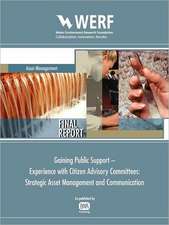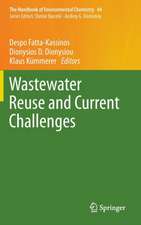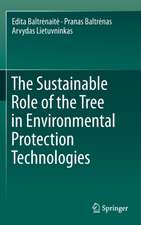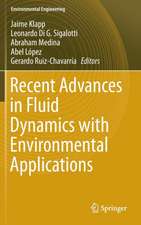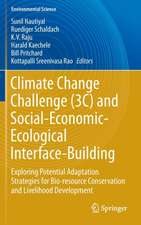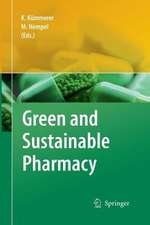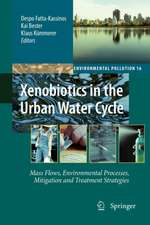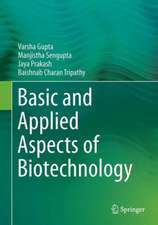Pharmaceuticals in the Environment: Sources, Fate, Effects and Risks
Editat de Klaus Kümmereren Limba Engleză Paperback – 19 oct 2010
| Toate formatele și edițiile | Preț | Express |
|---|---|---|
| Paperback (1) | 1144.71 lei 38-44 zile | |
| Springer Berlin, Heidelberg – 19 oct 2010 | 1144.71 lei 38-44 zile | |
| Hardback (1) | 1234.62 lei 6-8 săpt. | |
| Springer Berlin, Heidelberg – 14 aug 2008 | 1234.62 lei 6-8 săpt. |
Preț: 1144.71 lei
Preț vechi: 1486.63 lei
-23% Nou
Puncte Express: 1717
Preț estimativ în valută:
219.07€ • 227.87$ • 180.85£
219.07€ • 227.87$ • 180.85£
Carte tipărită la comandă
Livrare economică 08-14 aprilie
Preluare comenzi: 021 569.72.76
Specificații
ISBN-13: 9783642094125
ISBN-10: 3642094120
Pagini: 556
Ilustrații: XXXI, 521 p.
Dimensiuni: 155 x 235 x 29 mm
Ediția:Softcover reprint of hardcover 3rd ed. 2008
Editura: Springer Berlin, Heidelberg
Colecția Springer
Locul publicării:Berlin, Heidelberg, Germany
ISBN-10: 3642094120
Pagini: 556
Ilustrații: XXXI, 521 p.
Dimensiuni: 155 x 235 x 29 mm
Ediția:Softcover reprint of hardcover 3rd ed. 2008
Editura: Springer Berlin, Heidelberg
Colecția Springer
Locul publicării:Berlin, Heidelberg, Germany
Public țintă
ResearchCuprins
General Aspects.- Pharmaceuticals in the Environment – A Brief Summary.- Special Characteristics of Pharmaceuticals Related to Environmental Fate.- Sources, Occurrence and Fate.- Drug Production Facilities – An Overlooked Discharge Source for Pharmaceuticals to the Environment.- Substance Flows Associated with Medical Care – Significance of Different Sources.- Pharmaceutical Residues in Northern European Environments: Consequences and Perspectives.- Antibiotics in the Environment.- Veterinary Antibiotics in Dust: Sources, Environmental Concentrations, and Possible Health Hazards.- Fate of Veterinary Medicines Applied to Soils.- Pharmaceuticals as Environmental Contaminants: Modeling Distribution and Fate.- Environmental Exposure Modeling: Application of PhATE™ and Great-ER to Human Pharmaceuticals in the Environment.- Exposure Assessment Methods for Veterinary and Human-Use Medicines in the Environment: PEC vs. MEC Comparisons.- Effects.- Effects of Pharmaceuticals on Aquatic Organisms.- Another Example of Effects of Pharmaceuticals on Aquatic Invertebrates: Fluoxetine and Ciprofloxacin.- Effects of Antibiotics and Virustatics in the Environment.- Realizing the Potential Benefits of Small Animal Models for the Aquatic Hazard Assessment of Human Pharmaceuticals: A Conceptual Approach.- On the Ecotoxicology of Pharmaceutical Mixtures.- Chronic Mixture Toxicity of Pharmaceuticals to Daphnia – The Example of Nonsteroidal Anti-Inflammatory Drugs.- The Ecotoxicological Effects of Pharmaceuticals (Antibiotics and Antiparasiticides) in the Terrestrial Environment – a Review.- Odorants – Potent Substances at Minor Concentrations: The Ecological Role of Infochemicals.- Risk Assessment.- European Developments in the Environmental Risk Assessment of Pharmaceuticals.-The State and the Future Development/Perspective of Environmental Risk Assessment of Medicinal Products for Human Use: Aspects of Its Regulations in Japan.- Deterministic and Probabilistic Environmental Risk Assessment for Diazepam.- Comparison of Prospective and Retrospective Environmental Risk Assessments of Human Pharmaceuticals.- Methodological Aspects Concerning the Environmental Risk Assessment for Medicinal Products; Research Challenges.- Risk Management.- Strategies for Reducing the Input of Pharmaceuticals into the Environment.- Cost Action 636 Xenobiotics in the Urban Water Cycle – A Network for Collaboration within Europe.- Removal of Pharmaceutical Residues from Contaminated Raw Water Sources by Membrane Filtration.- Photooxidation as Advanced Oxidation Treatment of Hospital Effluents.- Pharmaceuticals and Environment: Role of Community Pharmacies.- Mitigation of the Pharmaceutical Outlet into the Environment – Experiences from Sweden.- Pharmaceutical Waste.
Recenzii
From the reviews of the third edition:
"This book gives a very good short, readable and impressive overview of the role and the fate of pharmaceuticals in the environment which was in the past totally neglected. It highlights the knowledge and the lack of knowledge of the today’s fast growing research area. The book should be a standard-lecture not only for ecologists, chemists and pharmacists … . Everybody whose work/interests stay in contact with the research … or the application of drugs can find some suitable information in this book." (Moritz Schübler, Clean, Vol. 37 (7), 2009)
"This book gives a very good short, readable and impressive overview of the role and the fate of pharmaceuticals in the environment which was in the past totally neglected. It highlights the knowledge and the lack of knowledge of the today’s fast growing research area. The book should be a standard-lecture not only for ecologists, chemists and pharmacists … . Everybody whose work/interests stay in contact with the research … or the application of drugs can find some suitable information in this book." (Moritz Schübler, Clean, Vol. 37 (7), 2009)
Caracteristici
Addresses the most important issues in the field of pharmaceuticals in the environment for the near future Typical examples and abundant data are presented


